The Winter Solstice, the shortest day of the year, holds special significance in Chinese communities, celebrated with family reunions and traditional dishes. Known as dongzhi in Mandarin and dung zit in Cantonese, this festival is marked by the preparation of tangyuan or tong yuen, glutinous rice dumplings symbolizing unity.
In southern China and Hong Kong, the sweet version of tangyuan is widely enjoyed, typically filled with black sesame or peanut paste and served in a ginger-infused syrup. Meanwhile, Southeast Asian versions often include pandan for a fragrant twist.
Less familiar but equally cherished is the Taishanese savory tangyuan. Originating from Taishan in Guangdong province—renowned as the “hometown of overseas Chinese”—this variation reflects the heritage of Taishanese emigrants who carried their traditions abroad. These dumplings are denser and smaller, served in an umami-rich broth of dried shrimp, shiitake mushrooms, and preserved Chinese sausage, alongside vegetables like cabbage and radish. Topped with spring onions and coriander, the dish is a hearty winter staple.
Second- and third-generation Taishanese have kept this tradition alive through shared recipes. Randy Lau of Made With Lau highlights its importance as a family legacy, while Lisa Lin’s Healthy Nibbles offers a vegan-friendly version incorporating kombu and lemongrass. Both creators emphasize tangyuan’s role as a comforting reminder of familial love and cultural roots.
The dish has also gained popularity through platforms like Smelly Lunchbox, where creator Susanna Yu shares her family’s recipe. Yu recalls rolling tangyuan with her brother while their parents prepared the broth, a tradition she now shares to preserve her heritage. Similarly, Jennifer Toy of Crazy Thick Asians connects her grandmother’s tangyuan to cherished childhood memories, further amplifying its cultural significance.
As more people share their stories and recipes, savory tangyuan is gaining recognition as a rich culinary tradition deeply rooted in Taishanese culture. It remains a symbol of love, family, and identity for generations past and future.
READ MORE:
